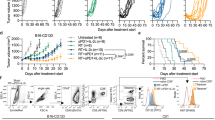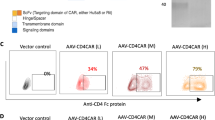Abstract
Gene transfer of various cytokines and co-stimulatory molecules has been reported to induce a potent antileukemic immunity in murine models, however, the relative efficiency and possible synergistic effects between candidate genes have not been extensively investigated. We analyzed in a murine model of BCR/ABL acute leukemia whether gene transfer of CD154, CD80 or GM-CSF as a single agent or combination of CD154 + GM-CSF, CD80 + CD154 and GM-CSF + CD80 in leukemic cells could enhance survival. We observed that CD154 gene transfer induced a marked inhibition of leukemogenicity, and also that CD154 and combination of GM-CSF and CD80 gene transfer protected mice against subsequent challenge with leukemic cells and had a therapeutic effect for a pre-established leukemia disease. We also found minimal residual leukemic disease by RT-PCR for 6 to 12 months in 0 to 25% of animals injected with transduced leukemic cells and surviving the challenge without evidence of disease, except in the control empty plasmid group where very few mice survived the challenge but all of those were positive by RT-PCR. These findings suggest that leukemic cell vaccination by gene transfer can induce a tumor dormancy phenomenon compatible with long-term survival.
This is a preview of subscription content, access via your institution
Access options
Subscribe to this journal
Receive 12 print issues and online access
$259.00 per year
only $21.58 per issue
Buy this article
- Purchase on Springer Link
- Instant access to full article PDF
Prices may be subject to local taxes which are calculated during checkout



Similar content being viewed by others
References
Gonzalez R et al. Increased gene transfer in acute myeloid leukemic cells by an adenovirus vector containing a modified fiber protein Gene Therapy 1999 6: 314–320
Boyer MW et al. The role of B7 costimulation by murine acute myeloid leukemia in the generation and function of a CD8+ T-cell line with potent in vivo graft-versus-leukemia properties Blood 1997 89: 3477–3485
Dilloo D et al. CD40 ligand induces an antileukemia immune response in vivo Blood 1997 90: 1927–1933
Dunussi-Joannopoulos K et al. Irradiated B7–1 transduced primary acute myelogenous leukemia (AML) cells can be used as therapeutic vaccines in murine AML Blood 1996 87: 2938–2946
Dunussi-Joannopoulos K et al. Gene therapy with B7.1 and GM-CSF vaccines in a murine AML model J Pediatr Hematol Oncol 1997 19: 536–540
Dunussi-Joannopoulos K et al. CD8+ T cells activated during the course of murine acute myelogenous leukemia elicit therapeutic responses to late B7 vaccines after cytoreductive treatment Blood 1997 89: 2915–2924
Dunussi-Joannopoulos K et al. Gene immunotherapy in murine acute myeloid leukemia: granulocyte-macrophage colony-stimulating factor tumor cell vaccines elicit more potent antitumor immunity compared with B7 family and other cytokinevaccines Blood 1998 91: 222–230
Dunussi-Joannopoulos K et al. Vaccines with interleukin-12-transduced acute myeloid leukemia cells elicit very potent therapeutic and long-lasting protective immunity Blood 1999 94: 4263–4273
Hirst WJ et al. Enhanced immune costimulatory activity of primary acute myeloid leukaemia blasts after retrovirus-mediated gene transfer of B7.1 Gene Therapy 1997 4: 691–699
Matulonis UA et al. Role of B7–1 in mediating an immune response to myeloid leukemia cells Blood 1995 85: 2507–2515
Matulonis U et al. B7–1 is superior to B7–2 costimulation in the induction and maintenance of T cell-mediated antileukemia immunity. Further evidence that B7–1 and B7–2 are functionally distinct J Immunol 1996 156: 1126–1131
Mutis T et al. CD80-transfected acute myeloid leukemia cells induce primary allogeneic T-cell responses directed at patient specific minor histocompatibility antigens and leukemia-associated antigens Blood 1998 92: 1677–1684
Nakazaki Y et al. Vaccine effect of granulocyte-macrophagecolony-stimulating factor or CD80 gene-transduced murinehematopoietic tumor cells and their cooperative enhancement ofantitumor immunity Gene Therapy 1998 5: 1355–1362
Stripecke R et al. Immune response to Philadelphia chromosome-positive acute lymphoblastic leukemia induced by expression of CD80, interleukin 2, and granulocyte–macrophage colony-stimulating factor Hum Gene Ther 1998 9: 2049–2062
Stripecke R et al. Combination of CD80 and granulocyte–macrophage colony-stimulating factor coexpression by a leukemia cell vaccine: preclinical studies in a murine model recapitulating Philadelphia chromosome-positive acute lymphoblastic leukemia Hum Gene Ther 1999 10: 2109–2122
Foroni L et al. Investigation of minimal residual disease in childhood and adult acute lymphoblastic leukaemia by molecular analysis Br J Haematol 1999 105: 7–24
Cave H et al. Clinical significance of minimal residual disease in childhood acute lymphoblastic leukemia. European Organization for Research and Treatment of Cancer – Childhood Leukemia Cooperative Group (see comments) N Engl J Med 1998 339: 591–598
Vereecque R et al. A new murine aggressive leukemic model (letter) Leukemia Res 1999 23: 415–416
Preudhomme C et al. Good correlation between RT-PCR analysis and relapse in Philadelphia (Ph1)-positive acute lymphoblastic leukemia (ALL) Leukemia 1997 11: 294–298
Vitetta ES et al. Tumor dormancy and cell signaling. V. Regrowth of the BCL1 tumor after dormancy is established Blood 1997 89: 4425–4436
Acknowledgements
This work was upported by the Ligue Contre le Cancer (Comité du Nord and Comité du Pas de Calais), the Association de Recherche sur le Cancer, the Association Recherche Transfusion, the Fondation contre la Leucémie, and the GEFLUC.
Author information
Authors and Affiliations
Rights and permissions
About this article
Cite this article
Vereecque, R., Buffenoir, G., Preudhomme, C. et al. Gene transfer of GM-CSF, CD80 and CD154 cDNA enhances survival in a murine model of acute leukemia with persistence of a minimal residual disease. Gene Ther 7, 1312–1316 (2000). https://doi.org/10.1038/sj.gt.3301228
Received:
Accepted:
Published:
Issue Date:
DOI: https://doi.org/10.1038/sj.gt.3301228
Keywords
This article is cited by
-
Fact or fiction - identifying the elusive multiple myeloma stem cell
Journal of Hematology & Oncology (2013)
-
Herpes simplex virus type-1 amplicon vectors for vaccine generation in acute lymphoblastic leukemia
Gene Therapy (2005)
-
Functional transfer of CD40L gene in human B-cell precursor ALL blasts by second-generation SIN lentivectors
Gene Therapy (2004)
-
γ-Irradiation enhances transgene expression in leukemic cells
Gene Therapy (2003)
-
Adenoviral transduction of tumor cells induces apoptosis in co-cultured T lymphocytes
Gene Therapy (2002)



